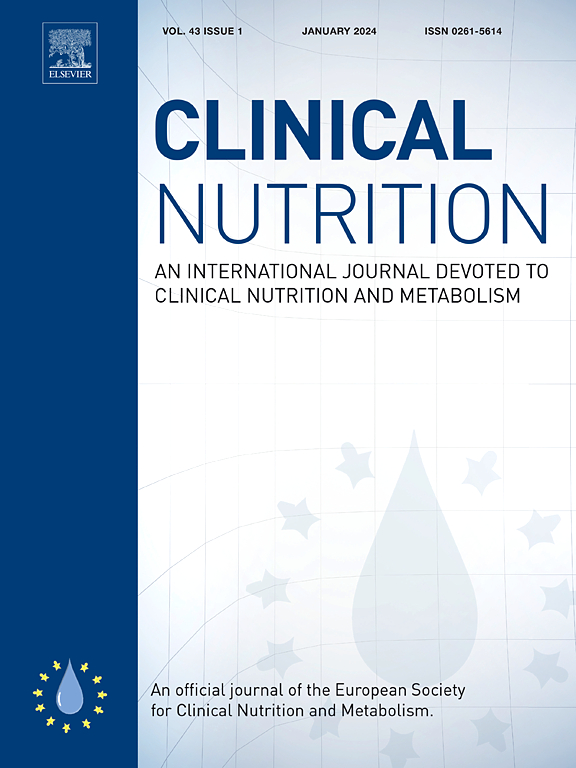多氟和全氟烷基物质(PFAS)在头1000天内会降低3岁时的线性生长、瘦体重和骨密度
IF 6.6
2区 医学
Q1 NUTRITION & DIETETICS
引用次数: 0
摘要
背景和目的聚氟烷基和全氟烷基物质(PFAS)是不可降解的人造化学品。它们被认为是“内分泌干扰化学品”(EDCs),这是一组干扰内分泌过程并对围产期、神经发育、代谢和生殖结果造成不利影响的化学品。特别是当暴露在易受影响的发育时期,如早期生活。纯母乳喂养(EBF)至少3个月的婴儿,在生命的“前1000天”内,PFAS血浆水平持续比纯配方奶粉喂养(EFF)的婴儿高3倍。然而,它们对生长和身体成分的影响尚不清楚。我们研究了生命早期血浆PFAS水平与3岁时的生长、身体组成和代谢结果之间的关系。其次,我们研究了PFAS对EBF-和ef -儿童的影响是否不同,以检验通过母乳接触PFAS是否会降低母乳喂养的已知健康益处。方法选取Sophia Pluto出生队列237例健康足月婴儿(EBF 99例,EFF 57例,mix 81例),在3岁时采用双能x线骨密度仪(DXA)测定人体测量学、血压、身体成分和全身骨密度(BMD)。采用液相色谱-电喷雾-电离串联质谱法(LC-ESI-MS/MS)测定3月龄和2岁患儿血浆中5种PFAS的含量。我们使用多元回归模型研究了3岁时血浆PFAS水平与预后之间的关系,并校正了混杂因素,如早期生活中的喂养习惯。结果3个月和2岁时较高的PFAS水平与从出生到3岁的线性生长较少相关(B: - 0.068, p = 0.004和B:-0.105, p <;0.001)和较短的高度SDS (B: - 0.063, p = 0.010和B:-0.099,p <;0.001)。此外,2岁时较高的PFAS水平与3岁时较低的瘦体质量(LBM) SDS和较低的BMDTotalBody SDS相关(B: - 0.064, p = 0.003和B:-0.075, p = 0.018)。相比之下,至少3个月的纯母乳喂养与相同的结果呈正相关(B: 0.204, p = 0.010和B: 0.274, p = 0.019)。结论出生后1000天较高的血浆PFAS水平与3岁时的身高、LBM和BMD SDS呈负相关,而出生后3个月的纯母乳喂养与这些结果呈正相关。这表明,生命早期血浆PFAS水平可能会危及母乳喂养已知的健康益处,这值得进一步研究。本文章由计算机程序翻译,如有差异,请以英文原文为准。
Poly- and perfluoroalkyl substances (PFAS) in the first 1000 days reduce linear growth, lean body mass and bone mineral density at age 3 years
Background and aims
Poly- and perfluoroalkyl substances (PFAS) are non-degradable, man-made-chemicals. They are considered to be ‘Endocrine Disrupting Chemicals’ (EDCs), a group of chemicals which interfere with endocrine processes and cause adverse effects on perinatal, neurodevelopmental, metabolic and reproductive outcomes. Especially when exposure occurs during susceptible periods of development, such as early life. Infants who had exclusive breastfeeding (EBF) for at least 3 months, have persistently 3-times higher PFAS plasma levels compared to infants who had exclusive formula feeding (EFF) during the ‘first 1000 days’ of life. However their effects on growth and body composition outcomes are lacking. We investigated the associations between early life plasma PFAS levels and growth, body composition and metabolic outcomes at age 3 years. Secondly, we studied if the influence of PFAS was different for EBF- and EFF-children, in order to examine if PFAS exposure through human milk diminishes the known health benefits of breastfeeding.
Methods
In 237 healthy term-born infants (99 EBF, 57 EFF and 81 mix), included in Sophia Pluto birth cohort, we determined anthropometrics, blood pressure, body composition and total body bone mineral density (BMD) by Dual-energy-X-ray Absorptiometry (DXA) at age 3 years. The plasma levels of 5 PFAS were determined by liquid-chromatography-electrospray-ionization-tandem-mass-spectrometry (LC-ESI-MS/MS) in samples collected at age 3 months and 2 years. We studied the associations between plasma PFAS levels and outcomes at age 3 years using multiple regression models, corrected for confounders, such as feeding practices in early life.
Results
Higher PFAS levels at age 3 months and 2 years were associated with less linear growth from birth until age 3 years (B: −0.068, p = 0.004 and B:-0.105, p < 0.001) and with shorter height SDS (B: −0.063, p = 0.010 and B:-0.099,p < 0.001) at age 3 years. Additionally, higher PFAS levels at age 2 years were associated with lower lean body mass (LBM) SDS and lower BMDTotalBody SDS at age 3 years (B: −0.064, p = 0.003 and B:-0.075, p = 0.018, respectively). In contrast, exclusive breastfeeding for at least 3 months was positively associated with the same outcomes (B: 0.204, p = 0.010 and B: 0.274, p = 0.019, respectively).
Conclusions
Higher plasma PFAS levels in ‘the first 1000 days’ of life were negatively associated with height, LBM and BMD SDS at age 3 years, while exclusive breastfeeding during the first 3 months of life was positively associated with these outcomes. This suggest that early life plasma PFAS levels could jeopardize breastfeeding's known health benefits, which warrants further research.
求助全文
通过发布文献求助,成功后即可免费获取论文全文。
去求助
来源期刊

Clinical nutrition
医学-营养学
CiteScore
14.10
自引率
6.30%
发文量
356
审稿时长
28 days
期刊介绍:
Clinical Nutrition, the official journal of ESPEN, The European Society for Clinical Nutrition and Metabolism, is an international journal providing essential scientific information on nutritional and metabolic care and the relationship between nutrition and disease both in the setting of basic science and clinical practice. Published bi-monthly, each issue combines original articles and reviews providing an invaluable reference for any specialist concerned with these fields.
 求助内容:
求助内容: 应助结果提醒方式:
应助结果提醒方式:


